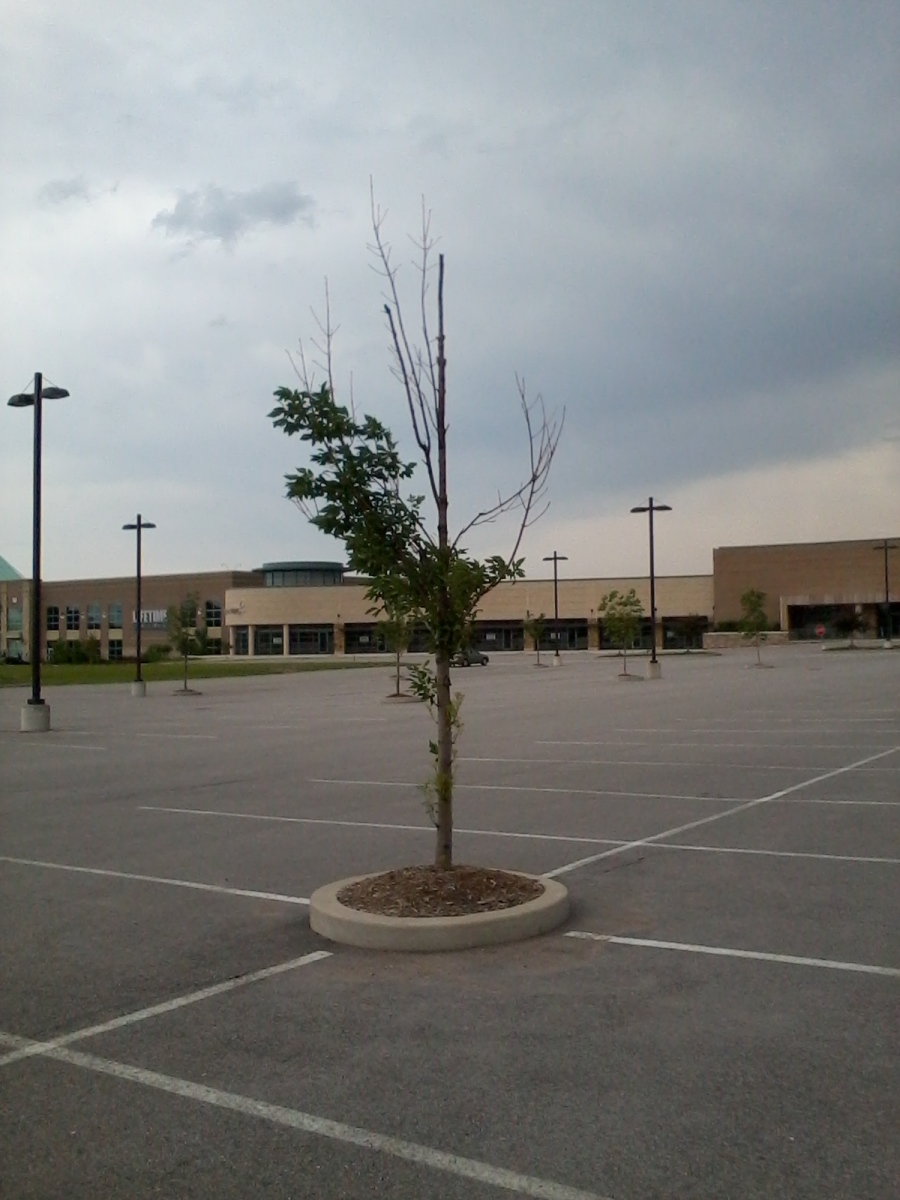Landscape Architecture for Landscape Architects › Forums › PLANTS & HORTICULTURE › Parking Lot Landscape Islands, what is the best approach?
- This topic has 1 reply, 17 voices, and was last updated 14 years, 3 months ago by
 Andrew Garulay, RLA.
Andrew Garulay, RLA.
-
AuthorPosts
-
August 25, 2011 at 11:07 pm #160760
 Jordan LockmanParticipant
Jordan LockmanParticipantEvery city writes their zoning code to include landscape islands in parking lots. They are to be a benefit to the end user, but instead we sometimes end up with a small lifeless desert of a dying tree, rock mulch, and weeds. That of course gets in the way of snow plowing. So what is the best way to go.
1. Islands that are big enough for trees, understory perennials, with wood mulch.
Great for tree and replicates nature with wood much holding moisture and understory plantings holding down weeds.
2. Islands ……, understory shrubs, and rock mulch.
Great for tree and sort of replicates nature but with rock mulch to be more permanent less maintenance.
3. Islands ….. and understory sod.
Well this is the one that seems to happen a lot and just does not work great, but it keeps things green.
4. Islands …. and understory aggressive groundcovers with wood mulch.
This I think should be the best one to go with a less manicured version of option #1. Great for plants, but does not look tidy.
5. No trees in islands and they all become rain gardens for parking lot runoff.
6. Another option altogether.
Great in areas with permeable soil and no de-icing salt! That is not what we have here.
Tell me what you think.
August 26, 2011 at 12:48 am #160822 Andrew Garulay, RLAParticipant
Andrew Garulay, RLAParticipantWhen I am not forced to make rain gardens (love the concept, hate the reality in small islands),my plants of choice are small ornamental grasses because they take a flogging and keep on trucking, so to speak. Woody plants break and continue to get big. Grasses max out on size and don’t damage vehicles while recovering nicely when “mistakes are made”.
August 26, 2011 at 4:03 am #160821 Wes Arola, RLAParticipant
Wes Arola, RLAParticipantDo you or anyone have a plant list or specific grasses that you would suggest for San Francisco bay area?
August 26, 2011 at 4:30 am #160820 Jason T. RadiceParticipant
Jason T. RadiceParticipantAh…my old nemesis, the parking lot island.
Your best bet is #4. Tree selection is VERY important, as parking lots generally have the worst soil and compaction issues. It depends where you are, and the width of the island, but deeper rooting trees (most often pioneer trees, not mature canopy trees) work the best. Many municipalities do not have the proper trees, or varieties of a species, on their approved planting list. In the mid-atlantic and northeast, where I am based…the Red Maple is the usual culprit. The species of the tree is perhaps the worst parking lot tree available, next to Bradford Pears.
One thing to keep in minds that many LAs, most engineers and landscape companies do not pay attention to is visibility. There should be a “clear zone” from 3′ to about 7′ above adjacent pavement level. The only thing that should be in this zone is a singular tree trunk for the shade tree. The clear zone allows clear views from inside vehicles to safely navigate the parking lot. All too often, the designer wants to screen the parked cars, this is the wrong thinking, and can be fatal at worst. Also, maintenance is a HUGE issue with this, as many designers rely on pruning or trimming to maintain visibility, maitenance which does not get performed. Judt don’t plant anything that gets that high natively and you are in good shape. Also try to avoid “mound” planting, where the soil is built up above the level of the curb and the root balls are simply buried in place. This leads to the tree not rooting properly. Make the contractor dig out the island and replace the soild with good growing medium.
August 26, 2011 at 1:20 pm #160819 Trace OneParticipant
Trace OneParticipantTwo words: solar panels..Take the challenge and make them look good. Run the parking lot lighting off them. Use them also as shade structures, although where you are you probably don’t want that…How about use them as benche structures? Nothing wrong with having a bench for granny to sit on when you hoisting the kids up the four steps to get in the giant Avalanche.
Of course, you may have to convince a planning department that solar panels consitute ‘landscaping’ – can thier processes be compared to photosynthesis, and therefor count as trees?
hee hee.
August 26, 2011 at 2:06 pm #160818Mike G
ParticipantMy suggestion would be minimum soil volumes. I would rather see one good island in a parking lot than four poor ones.
The ‘zoning code’ or city tree planting ordinance should read: Section 1.234: If its worth doing, do it right, otherwise don’t do it at all.
This picture was taken from an Arobor Day Foundation ‘Tree City,’
What a joke! This is not a unique problem, sadly a very common one.
August 26, 2011 at 2:21 pm #160817 Jordan LockmanParticipant
Jordan LockmanParticipantThat looks like the lot at the home depot near my house. When it was first installed I thought”now that is different and innovative, maybe there is some structural soil for the roots with some permeable pavement.” No just a tiny little landscape island installed with no thoughts or care about the tree the landscape maintenance or the end user. This installation at the home depot is part of what sent me on this quest in the first place. I just can’t believe my city allowed them. It is like sticking an oak tree in a #10 container and expecting it to get 50′ tall.
August 26, 2011 at 2:28 pm #160816 Jordan LockmanParticipant
Jordan LockmanParticipantI can always depend on you, Trace, for some crazy off the wall and maybe even impractical idea.
August 26, 2011 at 2:37 pm #160815 Jordan LockmanParticipant
Jordan LockmanParticipantFunny most people look at this tree and want to blame the tree for being diseased or something. Not the fact that there is no way that tree would ever work in that spot….
August 26, 2011 at 2:54 pm #160814Mike G
ParticipantYeah, it was born to fail. But in an ironic kind of way it’s more like a true forest tree, where only one one in a thousand something trees makes it from a seedling to maturity.
I have recently begun to take pictures of trees of declining trees in this type of situation. Hopefully to make a collage of sorts. I will know more about the use and purpose when I get there.
Again my vote is for for soil volume. Soil manages vegetation, soil manages runoff, soil is super awesome.
August 26, 2011 at 3:57 pm #160813 Jordan LockmanParticipant
Jordan LockmanParticipantI have been taking walks at lunch and every time I see a “Landscape OOPS” I take a picture. It is interesting to look back and understand why we exist. Fun to see spruce trees planted 2 feet from buildings, edging used as a retaining wall, trees planted in the middle of a concrete driveway and everything is heaving. Well It should make a good slideshow.
August 26, 2011 at 4:56 pm #160812 Mark LerchParticipant
Mark LerchParticipantCode minimums are just that. It is up to the L.A. to persuade the developer to go beyond the minimum. I know most owners/developers would rather maximize the opportunities for parking spaces, however trees that are planted in groups do better and have a greater chance of survival. So whether you decide to go with a low impact development strategy or not, double or triple the size of the islands which will host groups of trees and create some substantial landscape areas that really work. You may want to look at “Up By Roots” or Google Ed Gilman, IFAS pp presentations for help.
August 26, 2011 at 5:01 pm #160811 Mark LerchParticipant
Mark LerchParticipantFrom my commercial landscape plan review days… one applicant argued that there was nothing in the code that specifically excluded asphalt from being counted for area that contributed to % of ground cover.
August 26, 2011 at 6:02 pm #160810 Andrew Garulay, RLAParticipant
Andrew Garulay, RLAParticipantThe second you find a way to add to a landscape and still meet the parking requirements, the developer and/or his architect or engineer will add to the building or find some other way to snatch it all away from you. Perhaps that is why they are more often the Primary and LAs are not.
Each community sets its own values and applies them through regulation. Regulation tends to be more and more specific and covers a lot more agendas as time goes on. In most of the communities that I work in, the minimum standards are more than adequate to allow the long term survival of the plantings for which the standards are made.
Another question could be whether a landscape architect who sees how to max out a site has a responsibility to his client to apply that space toward the goals and objectives of the client or to use it for more green space. Much of the time, we are hired to find a way to put 10 pounds of crap into a five pound bag by balancing a lot of competing values in the favor of those paying for expertise for doing such. There is value to the developers in having us make it work. There is a burden to the developers when a design professional is working for a competing agenda.
Good minimum standards should be set by communities to dictate the rules of the game for developers to follow. If minimum standards are inadequate, the boards in control are at fault. If you need four feet, don’t make a minimum of 2′. Consultants and design professionals are generally hired to achieve the goals and objectives of the client within those rules. Hopefully, the goals and objectives of the client go beyond “the minimum”, but if they don’t, which is the right thing to do as a professional? Do you work toward maximizing the goals of the developer, or decide that you have the right to determine what the rules should be and what the client can and can not have? Are you more of a successful site designer if you add a thousand SF of building or a thousand SF of parking island? Which makes you more marketable?
Why do engineers and architects always seem to get our work?
August 26, 2011 at 6:13 pm #160809 Jordan LockmanParticipant
Jordan LockmanParticipantI have a number of parking lots where I could move some green space from outside the parking lot and into islands, but that costs more since that equals more pavement to drive past the increased islands So is it really ecologically an important thing to have trees in islands? Maybe they should be smaller so that the space outside the parking lot altogether can be made larger and that is where the trees go?
-
AuthorPosts
- You must be logged in to reply to this topic.



